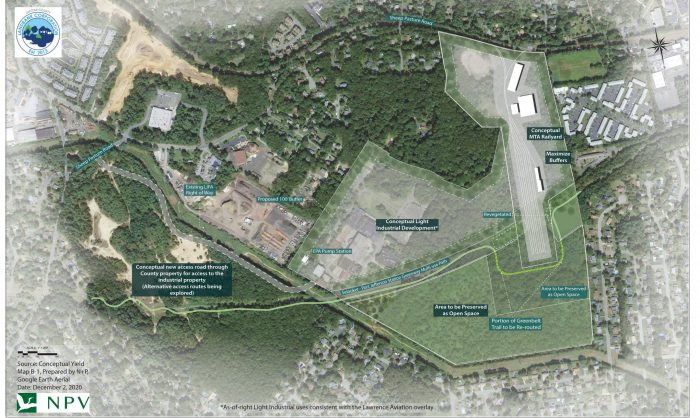Suffolk County Landbank works to find solutions for blighted Port Jeff Station property

The Suffolk County Landbank Corporation has been reaching out to local organizations to discuss ideas for the future of a 126-acre Superfund property in Port Jefferson Station.
The SCLBC has been reaching out to community members to see what they would like to see be done with the property. Recently, the nonprofit’s president, Sarah Lansdale, has been meeting with members of local chambers and civic associations about the property. The SCLBC has also reached out to elected officials such as county Legislator Kara Hahn (D-Setauket), state Assemblyman Steve Englebright (D-Setauket) and briefed the two school districts affected by the site due to unpaid property taxes: Comsewogue and Three Village.
According to Peter Scully, deputy Suffolk County executive and SCLBC board member, the landbank had been authorized by the state Legislature to facilitate cleanup of blighted sites, and then return the properties to the county tax rolls. The SCLBC is involved in discussions with both the Environmental Protection Agency and the U.S. Federal Department of Justice to talk about the future of the Lawrence Aviation property “and trying to make sure the community has some input into the future use,” Scully said.
One suggestion that has been considered is using a portion of the site as a Long Island Rail Road yard to facilitate electrification of the Port Jefferson Branch, he said. Scully added finding a suitable location along the branch for the railyard has been somewhat of a challenge with most of the communities fully developed.
Lansdale said that the land bank has received information from the Long Island Rail Road about what the environmental impact would be if the Port Jefferson Branch — from Huntington to Port Jefferson — were to be electrified.
“We would avoid approximately 7,800 metric tons of greenhouse gas emissions every year,” Lansdale said.
Other suggestions for the site from the community that have been discussed with the EPA and DOJ have been preserving part of it as open space and the possibility of allowing the section that has been developed in the past being available for redevelopment for light industrial purposes. There have also been suggestions to use the property for solar panels on the industrial core of the property.
According to Scully and Lansdale, the federal government has invested more than $50 million into the property.
“Generally what the federal government will do will be to try and recover as much of the funding that it has expended as it possibly can, and typically when the government does that, it looks at what assets are available that it could use,” Scully said, “And in this instance, the only real asset is the real property. And so, in the absence of any sort of other arrangement or agreement, the federal government would likely just auction the property off.”
Scully said the outreach has been well received by community members.
“I think there’s a general appreciation on the part of these stakeholders that under a more conventional scenario, if the federal government was simply to auction off this property to the highest bidder on the town hall steps, the ability to shape future uses to meet community needs would be lost,” he said.
In a May 19 letter on behalf of the U.S. Attorney for the Eastern District of New York, Mark Lesko — the former Town of Brookhaven supervisor — addressed to U. S. Magistrate Judge Anne Shields, Lesko stated that the U.S. and county “have made significant progress toward resolution of their outstanding issues, though not all matters are resolved.” An additional status report will be submitted to the district court on or before June 18.
The property, which was deemed a Superfund in 2000, has been surrounded by controversy since the early 1980s when the Suffolk County Department of Health issued a series of recommendations for the former defense contractor to be compliant with several pollution control laws. An April 2019 article in The Port Times Record reported that in 1999, testing performed by the New York State Department of Environmental Conservation revealed contamination of groundwater and surface water at the site.
According to the U.S. Attorney’s Office in a 2019 memorandum, LAI used a front-end loader to crush 55-gallon drums containing hazardous substances which led to discharge of waste directly into the ground. The drums were among more than 1,600. Gerald Cohen, former CEO of Lawrence Aviation, was ordered to pay $48 million in cleanup costs for the toxic underground plume caused by materials leached into the ground on the property.
The EPA’s cleanup on the site has included the treatment of contaminated groundwater using two groundwater treatment systems to decrease the size of the groundwater plume. One system is on the property while the other is in the village of Port Jefferson, according to Scully.
Regarding property taxes, Lansdale said 2020 taxes associated with Lawrence Aviation are in excess of $860,000. She added that “some parcels have been delinquent since 1993.”
“Every year that [taxes] haven’t been paid, Suffolk County taxpayers have been forced to bear the expense of making the other taxing jurisdictions whole,” Scully said, adding that means for school districts, fire districts and libraries.
“The tax burden associated with this property has been extreme,” he said.
While the county would typically take ownership of a property for nonpayment of taxes, when it comes to an environmental impairment such as Lawrence Aviation, the current situation absolves county taxpayers from the liabilities associated with environmental impairment, which would have a higher financial impact.






